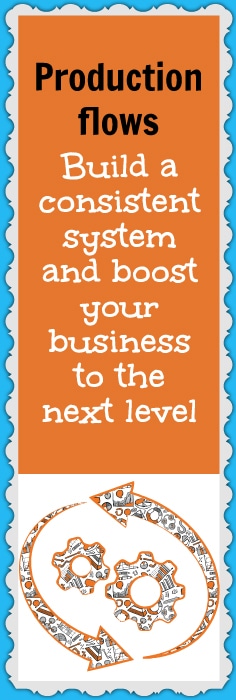Setting up a “production flow” can be the make or break for a business. And while it may not be super sexy, I’ve seen in LHS that it’s been the difference between big sellers and small sellers, between hobbyists and business owners.
If you want to create $3k, $5k, $10k+ a month with LHS, thinking like a big business and applying production flows is a great idea.
And if you’d like to bring in even more, you can take the next step by launching ads and creating production flows for that.
(I know, I used to not be such a big fan of ads. Don has been relentless in showing me how impactful they can be, so I’ve been testing them out and — he’s right. You’ll learn about this more over the next few weeks when Don’s Dropshipping on Demand comes out.)
Creating consistent production flows for both of these goals — pulling in $3k, $5k, $10k+ a month and scaling up with ads — helps you stay more organized and intentional about your progress.
The key is to always hold yourself accountable. Once you create a production flow, you need to stick to it.
Below, you’ll learn about the different types of production flows along with three examples of production flows pertaining to creating new designs and products, launching and optimizing ads, and combining those two tasks.
Let’s get started…
There are three types of production flows…
- Daily – Do this task every single day without fail (e.g. get one new design up).
- Weekly – Do this task every week without fail (e.g. get one new ad up).
- Coordination with your team – This refers to linking together different people or departments (e.g. designers, keyword researchers, those who launch the campaigns, etc.) so they can work hand-in-hand, matching each other’s capabilities and timelines to optimize your production flow.
You should be consistent with your production flows and make sure nothing gets in your way of following through.
Production flow for creating new designs & products
Creating new designs and products is key for your business’ growth. So you want to set design- and product-creation goals for yourself and then hold yourself accountable for meeting those goals each day and each week. Set a goal to create X amount of designs each day and get X amount of new products up each week.
For example, you could aim to create a production flow as follows…
Monday
Choose a niche to create designs for.
Tuesday
Create five new designs.
Wednesday
Launch five new products.
Thursday
Create five new designs.
Friday
Launch five new products.
Saturday
Take time off.
Sunday
Take time off.
Production flow for launching & optimizing ads
And if you want to scale up with your designs and products, you can start launching ad campaigns. Your ads are dependent on your new designs and products, however, as you can’t really launch new ads without having new products to promote. So make sure you’re diligent about sticking to your product-creation goals.
Below, you’ll find an example of a production flow for creating and launching new ads.
(NOTE: Launching ads isn’t part of the Low Hanging System, but if you want to ramp up your business, I do recommend doing this. And, again, you’ll learn more about this from Don’s Dropshipping on Demand.)
Monday
Launch one new ad.
Scale the ads up or down (ads from the previous week).
Tuesday
Optimize your ads.
Scale the ads up or down (ads from the previous week).
Wednesday
Launch one new ad.
Scale the ads up or down (ads from the beginning of the week).
Thursday
Optimize your ads.
Scale the ads up or down (ads from the beginning of the week).
Friday
Launch one new ad.
Scale the ads up or down (ads from the beginning of the week).
Saturday
Take time off.
Sunday
Take time off.
Production flow for both
After figuring out how many designs, products, and ads you want to launch each week, the next step is to combine those production flows so all of your goals progress simultaneously and harmoniously. Below, you’ll find an example of what I mean.
Monday
Choose a niche to create designs for.
Launch one new ad.
Scale the ads up or down (ads from the previous week).
Tuesday
Create five new designs.
Optimize your ads.
Scale the ads up or down (ads from the previous week).
Wednesday
Launch five new products.
Launch one new ad.
Scale the ads up or down (ads from the beginning of the week).
Thursday
Create five new designs.
Optimize your ads.
Scale the ads up or down (ads from the beginning of the week).
Friday
Launch five new products.
Launch one new ad.
Scale the ads up or down (ads from the beginning of the week).
Saturday
Take time off.
Sunday
Take time off.
After operating according to your initial production flows for 2-4 weeks, it’s time to double your numbers.
So, for example, if you start by launching 1-3 ads and 8-10 new designs and products a week, after a few weeks go by, double those numbers and start launching 3-6 ads and 16-20 new designs and products a week, always making sure to hold yourself (and your team) accountable.
And if you’d like to learn more about how to scale GOOD ads to make this part of the flow effective, I’ve got ya covered in the coming weeks.
What are your thoughts on production flows? Do you currently have any in place? If not, where could you use some? Please leave a comment and let me know!






0 thoughts on “Production flows – Build a consistent system and boost your business to the next level”
Thank you so much for this information ?